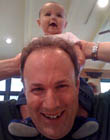|
|
This topic comprises 3 pages: 1 2 3
|
|
Author
|
Topic: Variety Pans Quality of Films Shot on DV
|
John Pytlak
Film God

Posts: 9987
From: Rochester, NY 14650-1922
Registered: Jan 2000
|
 posted 07-26-2002 07:01 AM
posted 07-26-2002 07:01 AM





Andrew Saidi of Kodak's ScreenCheck team sent me the following paragraph from a review of "Full Frontal" that appeared in "Daily Variety" on Thursday 7/25/2002 (the reviewer was Todd McCarthy)"The visual quality of the digital work is so unattractive -- flared lights, grainy textures, bad balance and unviewable faces abound -- that, after the likes of >this, "Bamboozled," "Tadpole" and most of the Danish Dogme films, one feels like boycotting all further digitally shot theatrical features until further notice." ------------------
John P. Pytlak, Senior Technical Specialist
Worldwide Technical Services, Entertainment Imaging
Research Labs, Building 69, Room 7525A
Rochester, New York, 14650-1922 USA
Tel: +1 585 477 5325 Cell: +1 585 781 4036 Fax: +1 585 722 7243
e-mail: john.pytlak@kodak.com
Web site: http://www.kodak.com/go/motion
| IP: Logged
|
|
Manny Knowles
"What are these things and WHY are they BLUE???"

Posts: 4247
From: Bloomington, IN, USA
Registered: Feb 2002
|
 posted 07-26-2002 10:45 AM
posted 07-26-2002 10:45 AM




I have had some VERY good results using DV-to-film, but then I've had a lot of practice (with commercials) so I know what to avoid...Wide shots (of people) that go too wide (unless you want faceless faces)
Low light and/or low contrast situations
Pans that aren't motivated (must be following something or else you have to pan slowly). For DV-to-film the best pans are "countered" by a dolly-move. The other problem I see a lot in other video-to-film stuff is bad editing. A small video monitor can fool you into thinking that certain cuts are working...and this may not be the case when the picture is projected. And then there's post-production. Not all transfer houses are created equally. I use Cinema Concepts in Atlanta. I won't name the houses in New York or Los Angeles that I used to use but I found it interesting that such horrible transfers could possibly come out of those cities. Audio is another factor. It took some experimentation before we came up with a satisfactory method of ensuring that the soundtracks would playback correctly in a cinema. My audio tracks are sync popped and then sent to a sound house in Los Angeles where a Dolby-SR negative is made. Most people don't seem to bother with allowing the extra time and money to get Dolby encoding and then they wonder why their "digital sound" is all muffled. As for grain...some people are actually stupid enough to add artificial grain to make the video look like it was shot on film. Of course, when the footage is transferred to film the effect is that there's twice as much grain. You wouldn't believe how common this problem is.
| IP: Logged
|
|
John Pytlak
Film God

Posts: 9987
From: Rochester, NY 14650-1922
Registered: Jan 2000
|
 posted 07-26-2002 11:07 AM
posted 07-26-2002 11:07 AM





Manny said:
"I know what to avoid...
Wide shots (of people) that go too wide (unless you want faceless faces)
Low light and/or low contrast situations
Pans that aren't motivated (must be following something or else you have to pan slowly). For DV-to-film the best pans are "countered" by a dolly-move."These techniques might be possible to do in simple commercials, but it is rather limiting for feature production. Another way DV production can look okay on a big screen ---- sit far away from the screen. Even NTSC or PAL can look okay from a distance of six screen heights. ------------------
John P. Pytlak, Senior Technical Specialist
Worldwide Technical Services, Entertainment Imaging
Research Labs, Building 69, Room 7525A
Rochester, New York, 14650-1922 USA
Tel: +1 585 477 5325 Cell: +1 585 781 4036 Fax: +1 585 722 7243
e-mail: john.pytlak@kodak.com
Web site: http://www.kodak.com/go/motion
| IP: Logged
|
|
Manny Knowles
"What are these things and WHY are they BLUE???"

Posts: 4247
From: Bloomington, IN, USA
Registered: Feb 2002
|
 posted 07-26-2002 11:14 AM
posted 07-26-2002 11:14 AM




Certainly it has its limitations. But that's the trade-off. It's like a zillion times cheaper...we can't have everything.The key is to select material that is better-suited to the medium. If your project (or your shooting style) demands film, then you need to sit tight until you can afford a bigger budget. You can't set out to create a great oil painting if all you've got is a box of crayons, right? I didn't find it too limiting. In fact, I found it to be a very liberating experience...I was making a movie instead of talking about how expensive/impossible it is to make a movie...Hopefully one day soon you'll be able to see my DV feature on film. 
| IP: Logged
|
|
|
|
|
|
Ian Price
Phenomenal Film Handler

Posts: 1714
From: Denver, CO
Registered: Jun 99
|
 posted 07-26-2002 05:19 PM
posted 07-26-2002 05:19 PM




Quote from Rodger Ebert regarding the film Sex & Lucia."NOTE: The film's digital photography is inadequate to the task of filming under the bright sun of the island. A portentous zoom to the sun is almost ruined because the image is so overexposed you hardly notice the sun. Since voluptuous visuals were obviously part of Medem's plan, he should have used film. Digital is still too anorexic for his purposes." Quote from Rodger Ebert about The Fast Runner. "Or we could begin with the story of the film's production. It was shot with a high-definition digital video camera, sidestepping the problems that cinematographers have long experienced while using film in temperatures well below zero."
| IP: Logged
|
|
|
|
John Pytlak
Film God

Posts: 9987
From: Rochester, NY 14650-1922
Registered: Jan 2000
|
 posted 07-26-2002 10:35 PM
posted 07-26-2002 10:35 PM





The 65mm film used to do the IMAX films shot outside the space shuttle in space, or on top of Mount Everest, certainly was up to the task of handling temperature extremes.BTW, digital cameras have to be heavily shielded in space --- the cosmic rays cause permanent "dead pixels". ------------------
John P. Pytlak, Senior Technical Specialist
Worldwide Technical Services, Entertainment Imaging
Research Labs, Building 69, Room 7525A
Rochester, New York, 14650-1922 USA
Tel: +1 585 477 5325 Cell: +1 585 781 4036 Fax: +1 585 722 7243
e-mail: john.pytlak@kodak.com
Web site: http://www.kodak.com/go/motion
| IP: Logged
|
|
Mark Ogden
Jedi Master Film Handler
Posts: 943
From: Little Falls, N.J.
Registered: Jun 99
|
 posted 07-27-2002 04:59 AM
posted 07-27-2002 04:59 AM




Oh boy. . .here I go playing devil's advocate again.Folks don't seem to realize that there is a big difference between digital cinematography and digital cinematography. Critics bust on Bamboozled, Tadpole, Sex and Lucia, The Anniversary Party and the forthcoming Full Frontal for their poor digital look. But these are all films shot on standard defination 'pro-sumer' and industrial cameras, not on HD cameras designed specially for electronic cinematography. There is a world of difference between the $3500 Canon XL1 and the $150,000 Sony Cine Alta or Thompson Viper (the same way there is a world of difference between my old Sears Super 8 load-n-shoot and a fully configured 35mm. Arriflex). As an example, people don't seem to have a lot to say about the look of Lovely And Amazing, which was shot on the Cine Alta with great care and taste by Nicole Holofcener and Harlan Bosmajin. I sat thru the entire film without once marking it as a video shoot, and it looked freakin' great. On the other hand, I saw Road to Perdition last week carefully projected on a large screen (at the Bridge Cinema in LA) and at several points in the movie the dancing film grain was enough to distract me from the dialog.
| IP: Logged
|
|
|
|
|
|
Manny Knowles
"What are these things and WHY are they BLUE???"

Posts: 4247
From: Bloomington, IN, USA
Registered: Feb 2002
|
 posted 07-27-2002 11:16 AM
posted 07-27-2002 11:16 AM




Mark Ogden wrote:Folks don't seem to realize that there is a big difference between digital cinematography and digital cinematography. ----- huh?
| IP: Logged
|
|
Mark Ogden
Jedi Master Film Handler
Posts: 943
From: Little Falls, N.J.
Registered: Jun 99
|
 posted 07-27-2002 11:35 AM
posted 07-27-2002 11:35 AM




Read my entire post again, Manny. Slowly.There is a difference between digital cinematography with consumer/industrial cameras and digital cinematography with High Defination 24p cameras. Capice?
| IP: Logged
|
|
Leo Enticknap
Film God

Posts: 7474
From: Loma Linda, CA
Registered: Jul 2000
|
 posted 07-27-2002 11:35 AM
posted 07-27-2002 11:35 AM





quote:
Hmm...Robert Flaherty didn't seem to have any problems with shooting 35mm for "Nanook of the North"....
He certainly did have problems. The camera Flaherty used was an Akeley - the only one of several he tried that was (i) able to be hand-operated, and (ii) did not seize up in the Arctic climate. One of the Akeley's many drawbacks was the magazine capacity of 100 feet, hence the fact that you never see any lengthy shots in that film. But I think the point you were trying to make is that he overcame the problems - not that he had any alternative, as Nanook was made four years before 16mm was invented. Neither did the 35mm format put off Herbert Ponting or Frank Hurley, who shot footage of the Scott and Shackleton expeditions to the Antarctic in 1911-12 and 1914-15 resepectively. BTW, not only did these people shoot 35mm in less than ideal circumstances, but they developed it and, when Flaherty was working on Man of Aran in 1933, he printed rushes in a field lab as well!
| IP: Logged
|
|
|
|
All times are Central (GMT -6:00)
|
This topic comprises 3 pages: 1 2 3
|
Powered by Infopop Corporation
UBB.classicTM
6.3.1.2
The Film-Tech Forums are designed for various members related to the cinema industry to express their opinions, viewpoints and testimonials on various products, services and events based upon speculation, personal knowledge and factual information through use, therefore all views represented here allow no liability upon the publishers of this web site and the owners of said views assume no liability for any ill will resulting from these postings. The posts made here are for educational as well as entertainment purposes and as such anyone viewing this portion of the website must accept these views as statements of the author of that opinion
and agrees to release the authors from any and all liability.
|

 Home
Home
 Products
Products
 Store
Store
 Forum
Forum
 Warehouse
Warehouse
 Contact Us
Contact Us




 Printer-friendly view of this topic
Printer-friendly view of this topic


















